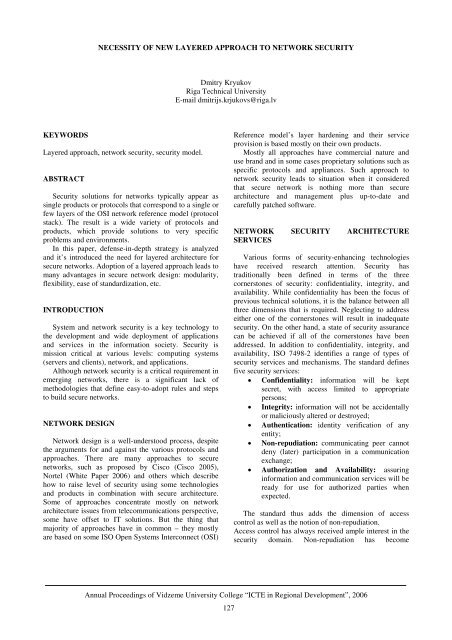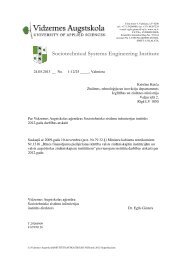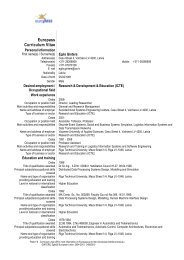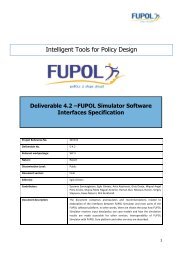Multimedia support issues can be presented by us<strong>in</strong>gthe Quality of Service (QoS) term, which is anoverloaded term with various mean<strong>in</strong>gs and perspectives.There is little consensus on the precise def<strong>in</strong>ition of QoS.Different people and communities perceive and <strong>in</strong>terpretQoS <strong>in</strong> different ways. For example, <strong>in</strong> the network<strong>in</strong>gcommunity, QoS refers to the service quality or servicelevel that the network offers to applications or users <strong>in</strong>terms of network QoS parameters, <strong>in</strong>clud<strong>in</strong>g latency ordelay of packets travel<strong>in</strong>g across the network, reliabilityof packet transmission, and throughput.However, <strong>in</strong> application communities, QoS generallyrefers to the application quality as perceived by theuser—that is, the presentation quality of the video, theresponsiveness of <strong>in</strong>teractive voice, and the sound quality(CD-like or FM-radiolike sound) of stream<strong>in</strong>g audio.APPLICATION REQUIREMENTS FOR QoSDifferent multimedia applications have different QoSrequirements expressed <strong>in</strong> terms of the follow<strong>in</strong>g QoSparameters as described <strong>in</strong> the previous section:throughput, delay, delay variation, and loss. In manycases, users can determ<strong>in</strong>e the application's QoSrequirements by <strong>in</strong>vestigat<strong>in</strong>g the factors that <strong>in</strong>fluencethe application quality (i.e., the task characteristics, usercharacteristics).For example, from experimentation they conclude thatfor acceptable quality, the one-way delay requirements of<strong>in</strong>teractive voice should be less than 250 ms. This delayvalue <strong>in</strong>cludes the delay <strong>in</strong>troduced from all components<strong>in</strong> the communication path such as source delay,transmission delay, network delay, and dest<strong>in</strong>ation delay.In this article, I focus on the applications'requirements for multimedia support <strong>in</strong> wirelessnetworks. Due to advances <strong>in</strong> the source and dest<strong>in</strong>ationavailable process<strong>in</strong>g power and the very high-speedoptical <strong>in</strong>frastructure, it’s expected to be delayed andbandwidth bottlenecks to occur <strong>in</strong> the wireless networkdue to their limited available bandwidth.Here is an overview of the factors that <strong>in</strong>fluence theapplication requirements. Some of the factors are asfollows:• Application <strong>in</strong>teractivity level: Interactive andnon<strong>in</strong>teractive applications• User/Application characteristics: Delaytolerance and <strong>in</strong>tolerance, adaptive andnonadaptive characteristics• Application criticality: Mission-critical and nonmission-criticalapplications.REALIZATION OF QoS SERVICESThere are a large number of approaches, mechanisms,and technologies deployed <strong>in</strong> the network <strong>in</strong> order toenable the QoS services <strong>in</strong>troduced <strong>in</strong> the previoussection. The bandwidth, which is the ma<strong>in</strong> networkresource, needs to be distributed to all applications <strong>in</strong> away that simultaneously satisfies all QoS requirements.To enable QoS services, there are two ma<strong>in</strong> approaches(philosophies) based on how they deal with bandwidthplann<strong>in</strong>g <strong>in</strong> order to enable QoS services:• Bandwidth over-provision<strong>in</strong>g: When the currentnetwork bandwidth cannot provide QoS support,the network <strong>in</strong>frastructure is upgraded. Us<strong>in</strong>g ahigher bandwidth <strong>in</strong>frastructure may result <strong>in</strong>less congestion and therefore lower deliverydelays;• Bandwidth management: This approachproposes to manage the bandwidth us<strong>in</strong>g QoSmechanisms.There is an endless argument between theimplementation of these two approaches. In wirednetworks, where bandwidth is abundant, overprovision<strong>in</strong>gis the w<strong>in</strong>n<strong>in</strong>g approach. However, <strong>in</strong>wireless networks where the bandwidth is limited(spectrum is unavailable or is too expensive to purchase)bandwidth management techniques have to be deployed.REFERENCESGanz, A., Z.Ganz and K.Wongthavarawat. 2003.Multimedia Wireless Networks: Technologies, Standards,and QoS.Mor<strong>in</strong>aga, N. 2002. Wireless communicationtechnologies.Flickenger, R., and R.Weeks. 2005. Wireless Hacks, 2ndEdition.BIOGRAPHYAleksejs Jurenoks is a master of science <strong>in</strong> computerscience (MSCS). Now he is a PhD student at RTUDivision of Applied <strong>Systems</strong> Software. He is a researcher<strong>in</strong> wireless technologies, mobile learn<strong>in</strong>g, and webtechnologies. He is an author of four educational booksand many <strong>in</strong>structional materials for teach<strong>in</strong>g differentcourses <strong>in</strong> the computer science field. Now isparticipat<strong>in</strong>g <strong>in</strong> IST 6FP project eLOGMAR-M (Webbasedand Mobile Solutions for Collaborative WorkEnvironment with Logistics and Maritime Applications).Annual <strong>Proceed<strong>in</strong>gs</strong> of Vidzeme University College “ICTE <strong>in</strong> Regional Development”, 2006126
NECESSITY OF NEW LAYERED APPROACH TO NETWORK SECURITYDmitry KryukovRiga Technical UniversityE-mail dmitrijs.krjukovs@riga.lvKEYWORDSLayered approach, network security, security model.ABSTRACTSecurity solutions for networks typically appear ass<strong>in</strong>gle products or protocols that correspond to a s<strong>in</strong>gle orfew layers of the OSI network reference model (protocolstack). The result is a wide variety of protocols andproducts, which provide solutions to very specificproblems and environments.In this paper, defense-<strong>in</strong>-depth strategy is analyzedand it’s <strong>in</strong>troduced the need for layered architecture forsecure networks. Adoption of a layered approach leads tomany advantages <strong>in</strong> secure network design: modularity,flexibility, ease of standardization, etc.INTRODUCTIONSystem and network security is a key technology tothe development and wide deployment of applicationsand services <strong>in</strong> the <strong>in</strong><strong>format</strong>ion society. Security ismission critical at various levels: comput<strong>in</strong>g systems(servers and clients), network, and applications.Although network security is a critical requirement <strong>in</strong>emerg<strong>in</strong>g networks, there is a significant lack ofmethodologies that def<strong>in</strong>e easy-to-adopt rules and stepsto build secure networks.NETWORK DESIGNNetwork design is a well-understood process, despitethe arguments for and aga<strong>in</strong>st the various protocols andapproaches. There are many approaches to securenetworks, such as proposed by Cisco (Cisco 2005),Nortel (White Paper 2006) and others which describehow to raise level of security us<strong>in</strong>g some technologiesand products <strong>in</strong> comb<strong>in</strong>ation with secure architecture.Some of approaches concentrate mostly on networkarchitecture issues from telecommunications perspective,some have offset to IT solutions. But the th<strong>in</strong>g thatmajority of approaches have <strong>in</strong> common – they mostlyare based on some ISO Open <strong>Systems</strong> Interconnect (OSI)Reference model’s layer harden<strong>in</strong>g and their serviceprovision is based mostly on their own products.Mostly all approaches have commercial nature anduse brand and <strong>in</strong> some cases proprietary solutions such asspecific protocols and appliances. Such approach tonetwork security leads to situation when it consideredthat secure network is noth<strong>in</strong>g more than securearchitecture and management plus up-to-date andcarefully patched software.NETWORK SECURITY ARCHITECTURESERVICESVarious forms of security-enhanc<strong>in</strong>g technologieshave received research attention. Security hastraditionally been def<strong>in</strong>ed <strong>in</strong> terms of the threecornerstones of security: confidentiality, <strong>in</strong>tegrity, andavailability. While confidentiality has been the focus ofprevious technical solutions, it is the balance between allthree dimensions that is required. Neglect<strong>in</strong>g to addresseither one of the cornerstones will result <strong>in</strong> <strong>in</strong>adequatesecurity. On the other hand, a state of security assurancecan be achieved if all of the cornerstones have beenaddressed. In addition to confidentiality, <strong>in</strong>tegrity, andavailability, ISO 7498-2 identifies a range of types ofsecurity services and mechanisms. The standard def<strong>in</strong>esfive security services:• Confidentiality: <strong>in</strong><strong>format</strong>ion will be keptsecret, with access limited to appropriatepersons;• Integrity: <strong>in</strong><strong>format</strong>ion will not be accidentallyor maliciously altered or destroyed;• Authentication: identity verification of anyentity;• Non-repudiation: communicat<strong>in</strong>g peer cannotdeny (later) participation <strong>in</strong> a communicationexchange;• Authorization and Availability: assur<strong>in</strong>g<strong>in</strong><strong>format</strong>ion and communication services will beready for use for authorized parties whenexpected.The standard thus adds the dimension of accesscontrol as well as the notion of non-repudiation.Access control has always received ample <strong>in</strong>terest <strong>in</strong> thesecurity doma<strong>in</strong>. Non-repudiation has becomeAnnual <strong>Proceed<strong>in</strong>gs</strong> of Vidzeme University College “ICTE <strong>in</strong> Regional Development”, 2006127
- Page 1 and 2:
ISBN 9984-633-03-9Annual Proceeding
- Page 3 and 4:
“Development of Creative Human -
- Page 5 and 6:
TABLE OF CONTENTSINTELLIGENT SYSTEM
- Page 7 and 8:
INTELLIGENT SYSTEM FOR LEARNERS’
- Page 9 and 10:
LEARNER 1GROUP OF HUMAN AGENTSLEARN
- Page 11 and 12:
QuantityQuantityFigure 6. Distribut
- Page 13 and 14:
LEARNERStructure of theconcept mapL
- Page 15 and 16:
WEB-BASED INTELLIGENT TUTORING SYST
- Page 17 and 18:
materials to be presented and which
- Page 19 and 20:
INFORMATION TECHNOLOGIES AND E-LEAR
- Page 21 and 22:
correspondence with the course aim
- Page 23 and 24:
projects and through IT. Hence, it
- Page 25 and 26:
APPLICATION OF MODELING METHODS IN
- Page 27 and 28:
can support configuration managemen
- Page 29 and 30:
The EKD is one of the Enterprise mo
- Page 31 and 32:
CHANGES TO TRAINING AND PERSPECTIVE
- Page 33 and 34:
or an end, yet none of these attitu
- Page 35 and 36:
make decisions. It cannot be volunt
- Page 37 and 38:
logs), data and video conferencing
- Page 39 and 40:
Ability to follow user’s multi-ta
- Page 41 and 42:
CONCLUSIONSEDUSA method gives us a
- Page 43 and 44:
in successful SD. Given this situat
- Page 45 and 46:
SPATIAL INFORMATIONFor the visualis
- Page 47 and 48:
MOBILE TECHNOLOGIES USE IN SERVICES
- Page 49 and 50:
learning environment (Learning Mana
- Page 51 and 52:
ago only some curricula on Logistic
- Page 53 and 54:
The Web-based version can be access
- Page 55 and 56:
Web-portal, which incorporates diff
- Page 57 and 58:
DO INTELLIGENT OBJECTS AUTOMATICALL
- Page 59 and 60:
Table 1. Examples for introducing R
- Page 61 and 62:
workable influencing of the process
- Page 63 and 64:
are handed over to the objects and
- Page 65 and 66:
• Basic processes, such as wareho
- Page 67 and 68:
THE ECR E-COACH: A VIRTUAL COACHING
- Page 69 and 70:
participating in the workshops and
- Page 71 and 72:
• Assessment modules enable indiv
- Page 73 and 74:
with pictures and illustrated graph
- Page 75 and 76:
ECR Question Banknumber category su
- Page 77 and 78:
educational programme that follows
- Page 79 and 80:
DEVELOPMENT OF WEB BASED GRAVITY MO
- Page 81 and 82: These results of a model require a
- Page 83 and 84: CONCLUSIONSThe main goal of work ha
- Page 85 and 86: dimension and included within any o
- Page 87 and 88: • Resources sharing by providing
- Page 89 and 90: Pursuant to the guidelines of elect
- Page 91 and 92: tariffs of regulated services have
- Page 93 and 94: INFORMATION TECHNOLOGY FOR MOTIVATI
- Page 95 and 96: difficult to predict when and for w
- Page 97 and 98: Listeners' workon the WebListenersS
- Page 99 and 100: PERSPECTIVES OF WEB PAGE AND E-MAIL
- Page 101 and 102: INCREASE IN THE NUMBER OF INTERNETU
- Page 103 and 104: tourism accommodations (home pages
- Page 105 and 106: interactive relationships with clie
- Page 107 and 108: • The data obtained by the resear
- Page 109 and 110: Central Statistical Bureau of Latvi
- Page 111 and 112: departures for 1995 are taken from
- Page 113 and 114: 120100maximumworldminimum806040200-
- Page 115 and 116: 140120maximumworldminimum1008060402
- Page 117 and 118: would be a promising extension. Cur
- Page 119 and 120: AN OVERVIEW OF THE AGENT − BASED
- Page 121 and 122: Suitability for social system simul
- Page 123 and 124: 6. MASONDescription:MASON is a fast
- Page 125 and 126: Suitability for social system simul
- Page 127 and 128: could be bad particularly when over
- Page 129 and 130: (for 10 repeat &| CCar[]->runfor);P
- Page 131: • Streaming audio• Collaboratio
- Page 135 and 136: Up to now, there has only been limi
- Page 137 and 138: aaaaa6= −aa2,1 = − a0,3226= −
- Page 139 and 140: ∂ u∂x∂ u∂y2 2+ b = 02 2wher
- Page 141 and 142: a6,3= −2030a4,5−130a4,3- - - -
- Page 143 and 144: 0,10,20,30,4( )Mag x y y Ge wx2, =
- Page 145 and 146: Example 1. To understand better the
- Page 147 and 148: Therefore, further the following co
- Page 149 and 150: SOLUTION OF THE THREE-DIMENSIONALEQ
- Page 151 and 152: Mag1, m , m , m1 2 3= mm1 m2m32 2 2
- Page 153 and 154: MagMag0, m , m , m1 2 31, m , m , m
- Page 155: CONCLUSIONSThe basic content of thi









